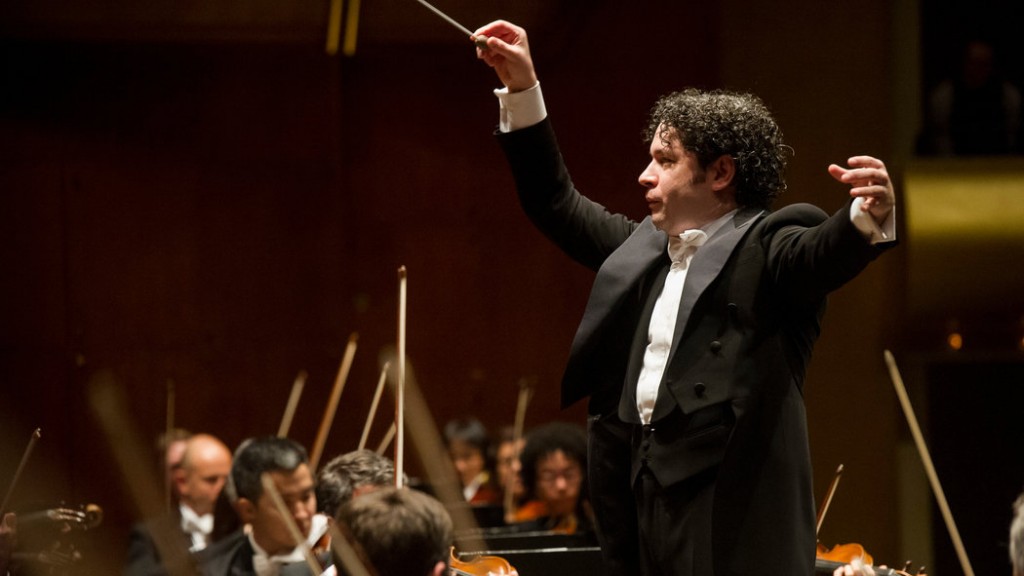I often think of orchestral concert programming in terms of meal planning. Be it a simple classic French procession of dishes in the 2- or 9-course meal.
Any concert should start with some kind of Hors D’oeuvres – a scrumptious nibbler that stimulates the appetite. Only then should it move into the more elaborate main course dish accompanied by a garnish of some kind. A dessert course is nice, and should be comprised of something sweetly indulgent and beautifully decorated. Better yet, cap it all off with a small demitasse of freshly brewed musical energy to accent the sweets of the evening.
On Wednesday night, megastar conductor Gustavo Dudamel and the Los Angeles Philharmonic made a stop in Toronto to present an all main course program of works that left one missing a sense of lead-up and cadence to the evening.
Meaty programs can be captivating, but sometimes the relationships between them can overshadow each other, and that is what happened here.
The first of the two 45-minute symphonies was John Corigliano’s very personal “Symphony No. 1”. The four-movement work is about the tragedy of AIDS, an epidemic that has affected him deeply.
“I was extremely moved when I first saw “The Quilt,” an ambitious interweaving of several thousand fabric panels, each memorializing a person who had died of AIDS, and, most importantly, each designed and constructed by his or her loved ones.”
The first movement – Apologue: Of Rage and Remembrance, is bookended with an insistent “A” pitch, which is constantly interrupted by punching stabs of discordant colour in the percussion or brass. This yields to the strings playing a haunting lullaby, juxtaposed with an eerie off-stage piano quoting a Tango by Isaac Albéniz.
The Tango was a favourite work of Corigliano’s friend, from which the movement is mirrored. In many ways, the off-stage piano signifies the memory of a loved one – as an ephemeral and internalised essence. It is a striking technique that returns a few times in the movement.
The second “Tarantella,” movement opens with a shrill intro and moves into intermittent dance rhythms frequently interrupted by rowdy brass and percussion swings. There is a feeling of panic in this movement that Corigliano describes as a brutal scream. Dudamel took this energy to heart, but maintained a near perfect control of the orchestra’s complex entrances. It was particularly interesting to hear the four mandolins contribute to the Tarantella flavour of the movement.
The third Chaconne movement, written in the memory of an amateur cellist gave way to the highlight of the work – a duet between the two principal cellists, Robert deMaine and Ben Hong. It was a warm interaction that evoked the loving relationship between two musical characters. This movement also recalled the insistent “A” which returns in the brass, then strings, all leading the way towards a mesmerizing funeral march interpreted with a disturbing sense of unease.
The final Epilogue, pulls the symphony together reprising elements from each movement, including the off-stage piano, the clarinet presenting a Tarantella folk tune, and the final “A” drone in the solo cello.
The second half of the concert proceeded with Tchaikovsky’s Fifth, one of his most well-liked and beautiful works, particularly with the austere motif that begins the first movement and recurs throughout its four movements.
The sound of the LA Phil was a tad bright in Roy Thomson Hall, but they seemed to be on a mission to prove why their virtuosic sound and tight-swelling Hollywood-orchestra styled strings are something to be reckoned with. Their interpretation of Tchaikovsky was certainly interesting, but for my taste was on the verge of being just over the top. That said, I think they treaded the line, and most importantly, Dudamel let Toronto know why he and the LA Phil are just as bright as the California sunshine.
The second movement was carried by an entrancing horn solo, repeated in the cellos. Dudamel pulled out varying textures from the work to create a mixed feeling of tension and composure. The third movement began with careful restraint that gave way to a Waltz that could have accompanied a ballet. It quickly breaks into the motto theme in the brass and then a more solemn slow tempo that Dudamel carried with slow assurance.
The finale, afforded a rewarding conclusion in the eminent restatement of the motto that launches into a full allegro with a fist full of fury. Here, Dudamel flaunted the works underbelly, drawing rich support from the secondary voices and guiding the piece to a commanding finish with broad, sweeping grandeur.
My only complaint with the overall programme was that the order of works as presented was flawed. This widespread bias towards putting contemporary pieces on the first half of a concert is a notion that poisons any good sense of musical digestion. Simply categorizing a work based on the date of its conception without any concern for its contents is mind-blowing. Also considering the lengthy ovation the Corigliano piece received, the anticlimactic feeling hung throughout the room like a drunken elephant well past the intermission.
Michael Vincent
- THE SCOOP | Royal Conservatory’s Dr. Peter Simon Awarded The Order Of Ontario - January 2, 2024
- THE SCOOP | Order of Canada Appointees Announced, Including Big Names From The Arts - December 29, 2023
- Ludwig Van Is Being Acquired By ZoomerMedia - June 12, 2023




